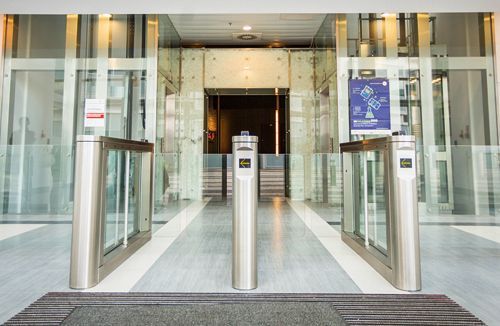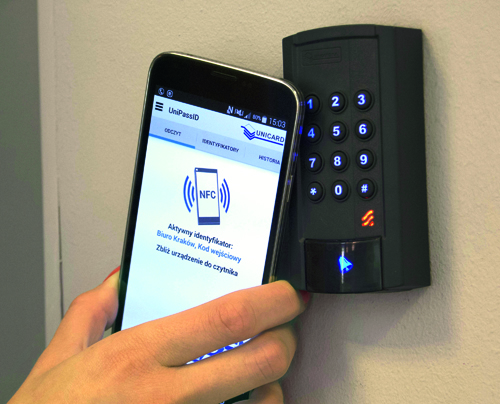A smarter form of access
Property management
What will access control look like in the future? The tenants of Mennica Legacy Tower in Warsaw’s Wola district, which developer Golub GetHouse is planning to complete in Q4 next year, will be among the first in the country to open their doors using their mobile phones. Or, the doors will be opened automatically by the access control system in the building communicating with the smartphone and recognising the person entering. However, this would require additional authorisation from those entering the secure zone. It might be necessary to punch in a PIN number or have your thumb scanned. “Thanks to this you will be able to go though the security gates and the system will automatically call a lift to the floor you usually work on and the phone will tell you which lift to go to,” explains Czarek Jarząbek, the founder and CEO of Golub GetHouse, about the company’s plans. It will also be possible to enter the office using a smartphone and after that adjust the lighting, the blinds and the air-conditioning. The application used will also give you access to other services, such as ordering food and opening the bicycle storage room.

Guests of the Warsaw Financial Center building (but not yet the tenants) can already use their phones in this way. Those who want to visit the building can register their intentions on the building’s website. The form, which can be filled in within a minute, requires you to provide your data, the name of the tenant you want to visit, and the time and the reason for the meeting. If the tenant accepts the notification, an access code will be sent to their mobile phone, which will be used for opening the entrance doors. Unicard, a distributor of similar systems, is currently in talks with one potential corporate client over the instalment of a similar system in Kraków. “The need arose from the fact that the company holds recruitment meetings at weekends and these involve appointing a member of the staff to man the entrance. Instead of this we can provide a service-free system,” explains Anna Tatucha, the business communication manager at Unicard. To prevent the guests wandering around the building unsupervised, the code only allows them to open certain doors and access to a certain floor.
The pros and cons
So what are the main advantages of using a smartphone for access control? Firstly, it is a more valuable device than a card, so it would tend to be more looked after. “Our experience shows that people lose cards more often than phones,” says Anna Tatucha. Furthermore, people realise they have lost their phones sooner than in the case of a card, which is important knowledge for the building’s security. A phone can also be used to open gates or parking barriers. Pavel Dolezal, the area sales manager of American company HID Global, explains that they can be used by long-range readers (e.g. by using the Bluetooth Smart system), to open barriers without needing to leave the car or stopping to wind down your window. In addition, mobile systems allow authorisations to be processed, by removing the need for a separate physical system for coding, printing or receipts.
Nonetheless, mobile access control systems have yet to make their mark in Poland. “This kind of system is not well known, or rather, simply not used in Poland,” says Maciej Markowski, a partner and CEE head of workplace strategy for global occupier services at Cushman & Wakefield. Developers such as Ghelamco, GTC, HB Reavis and Skanska do not seem to have any definite plans in this respect. Magdalena Cielczko, the marketing director of Echo Polska Properties, explains that the introduction of such mobile technology in existing facilities would make little sense because replacing existing systems would incur significant costs. Anna Tatucha adds that the development of mobile systems is still in its early stages. Unicard has been working on an app that constantly updates itself to the latest version of Android and that would be compatible with a range of phones and settings. “We have not had many of these systems installed, just a handful at the most,” admits the representative of Unicard. Even though the applications the system uses do not need much to power them, the system obviously breaks down when your phone’s battery runs down or when you lose your phone. So what happens then? “You would have to enter your code manually,” explains Anna Tatucha.
Biometrics not for office buildings
The issue of lost equipment could be resolved by using biometric systems. A thumbprint, an iris scan or a face image could be used to remove the need for people to carry unnecessary ‘keys’. Even though well-known futurist Ian Pearson expects that physical access cards will have disappeared from our wallets by 2025, this still seems a distant prospect. Regulations (including those imposed by the EU) have been introduced to protect us against scenarios such as those portrayed in the movie ‘Minority Report’ (based on a short story by Philip K. Dick) in which technology robs citizens of all their privacy. According to this disturbing vision of the future, ubiquitous eye retina scanners identify individuals wherever they go.
Biometric solutions, even though they might seem to be simple and practical, have little chance of being widely introduced in office buildings due to the legal regulations in force in Poland. “In principle, office building owners are not allowed to install door opening systems, for example, that use fingerprints to record working times. However, there is an exception to this: such systems are permitted for securing the doors to rooms where the employer’s confidential materials are stored,” explains Justyna Stefańczyk-Kaczmarzyk, a legal counsel and partner of the Kondrat and Partners law firm in Warsaw. According to the current interpretation of the law, even the consent of the employee does not authorise the employer to use biometric data. “The position of the Chief Inspector of Personal Data Protection is that the employer has no such right even with the consent of the employee. However, the exception to this is that it is possible to process such biometric data under art. 23 section 1 item 5 of the personal data protection act, when it is in the employer’s justified interest to protect certain areas, such as treasuries and confidential archives, against unauthorised access,” adds Justyna Stefańczyk-Kaczmarzyk.
Sebastian Biedrzycki, an associate director and head of office and industrial asset services at CBRE, emphasises that the legality of such systems is not the only issue, but also tenants’ concerns have to be taken into account. Companies are engaged in a battle over the best employees on today’s market, so they have to demonstrate special care for their well-being. The worry clearly is that access control systems based on biometric data readings could be perceived as too repressive. Perhaps in the future, if the security environment deteriorates and people feel more threatened, such systems would have a greater chance of being adopted. “But for the moment tenants would probably prefer to have sports facilities rather than advanced access control systems,” believes Sebastian Biedrzycki.
Smartphones once again
Access control not only increases the security level in the building, it also gathers data on the people using it. This could be crucial in the event of an evacuation of the building, since we would know who was still inside the building. Some tenants, particularly large corporations, can additionally combine access control systems with their work time control systems. Combining access control systems with BMS is also becoming the standard, since this makes it easier to adjust the ventilation and heating.
Mobile control, which does not evoke such negative emotions as biometrics, is likely to be the technology of the future. “Its popularisation is just a matter of time,” says Maciej Markowski. The first to use it are likely to be co-working space providers and IT firms. One factor that seems to support its eventual spread is the younger generation’s greater attachment to mobile devices. Added to that is the fact that people would clearly prefer to use their smartphones instead of having to carry ten different magnetic cards. And what about the costs? As the representative of Unicard explains, an average access control system with 100 monitored passageways (as well as the necessary equipement, the cabling and programing) costs around PLN 200,000, not including the gates at the building's entrance (PLN 50,000-60,000 per unit), lift terminals (PLN 5,000 per lift) and magnetic cards (PLN 10 per card). A system which uses also QR codes also requires an additional PLN 20,000 investment. In the case of a mobile system the overall cost increases by a few percent.





















































